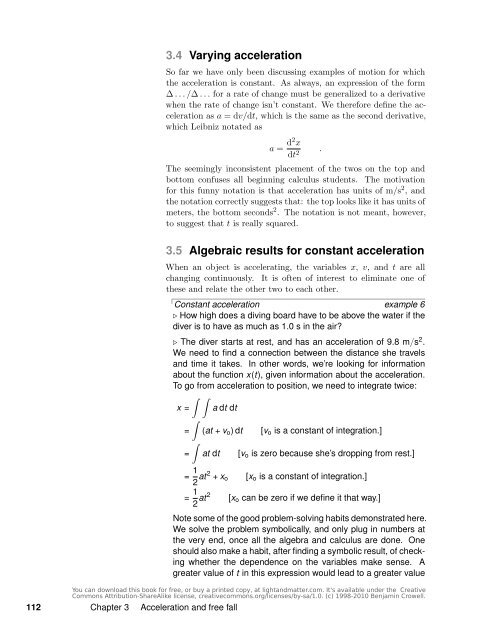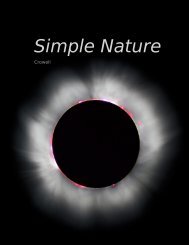Chapter 3 Acceleration and free fall - Light and Matter
Chapter 3 Acceleration and free fall - Light and Matter
Chapter 3 Acceleration and free fall - Light and Matter
Create successful ePaper yourself
Turn your PDF publications into a flip-book with our unique Google optimized e-Paper software.
3.4 Varying acceleration<br />
So far we have only been discussing examples of motion for which<br />
the acceleration is constant. As always, an expression of the form<br />
∆ . . . /∆ . . . for a rate of change must be generalized to a derivative<br />
when the rate of change isn’t constant. We therefore define the acceleration<br />
as a = dv/dt, which is the same as the second derivative,<br />
which Leibniz notated as<br />
a = d2 x<br />
dt 2<br />
The seemingly inconsistent placement of the twos on the top <strong>and</strong><br />
bottom confuses all beginning calculus students. The motivation<br />
for this funny notation is that acceleration has units of m/s 2 , <strong>and</strong><br />
the notation correctly suggests that: the top looks like it has units of<br />
meters, the bottom seconds 2 . The notation is not meant, however,<br />
to suggest that t is really squared.<br />
3.5 Algebraic results for constant acceleration<br />
When an object is accelerating, the variables x, v, <strong>and</strong> t are all<br />
changing continuously. It is often of interest to eliminate one of<br />
these <strong>and</strong> relate the other two to each other.<br />
Constant acceleration example 6<br />
⊲ How high does a diving board have to be above the water if the<br />
diver is to have as much as 1.0 s in the air?<br />
⊲ The diver starts at rest, <strong>and</strong> has an acceleration of 9.8 m/s2 .<br />
We need to find a connection between the distance she travels<br />
<strong>and</strong> time it takes. In other words, we’re looking for information<br />
about the function x(t), given information about the acceleration.<br />
To go from acceleration to position, we need to integrate twice:<br />
� �<br />
x = a dt dt<br />
�<br />
= (at + vo) dt [vo is a constant of integration.]<br />
�<br />
= at dt [vo is zero because she’s dropping from rest.]<br />
= 1<br />
2 at2 + xo<br />
= 1<br />
2 at2<br />
112 <strong>Chapter</strong> 3 <strong>Acceleration</strong> <strong>and</strong> <strong>free</strong> <strong>fall</strong><br />
[xo is a constant of integration.]<br />
[xo can be zero if we define it that way.]<br />
Note some of the good problem-solving habits demonstrated here.<br />
We solve the problem symbolically, <strong>and</strong> only plug in numbers at<br />
the very end, once all the algebra <strong>and</strong> calculus are done. One<br />
should also make a habit, after finding a symbolic result, of checking<br />
whether the dependence on the variables make sense. A<br />
greater value of t in this expression would lead to a greater value<br />
.














